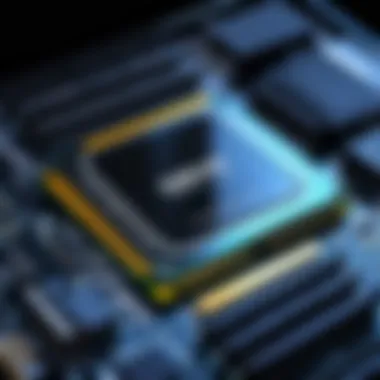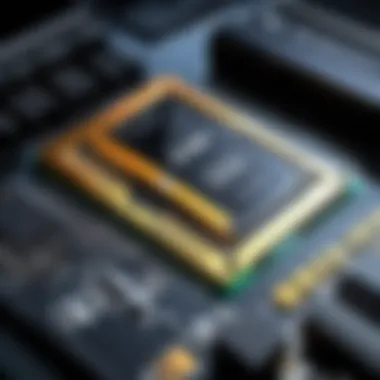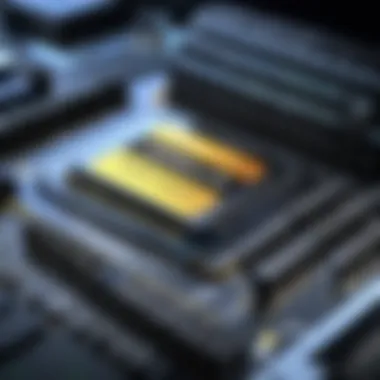Exploring Top DDR4 RAM Options for Optimal Performance


Intro
In the realm of computer hardware, Random Access Memory (RAM) stands as a crucial component that significantly influences system performance. With the introduction of DDR4 RAM, users can experience improved speed and efficiency compared to its predecessors. This guide delves into the prominent options available in the DDR4 segment, aiming to provide tech-savvy individuals with insights that aid in making informed purchasing decisions.
Key Features
When evaluating DDR4 RAM, several key features warrant attention. These characteristics will impact overall system performance and user experience.
Design and Build Quality
The physical design and build quality of RAM modules are essential for durability and stability. Most high-performance DDR4 RAM modules come with heatsinks that dissipate heat effectively, allowing for sustained performance during intensive tasks. Brands like Corsair and G.Skill offer designs that not only serve a functional purpose but also enhance the visual aesthetics of your build. Additionally, RAM sticks often come in various colors to complement different themes.
Display and Performance
Performance indicators of RAM include clock speed, CAS latency, and capacity. DDR4 memory typically ranges from 2133 MHz to 4000 MHz or higher. Higher speeds result in improved data transfer rates, contributing to better performance in gaming and productivity tasks. CAS latency, measured in clock cycles, is also crucial—lower numbers indicate quicker response times. Evaluating these metrics will guide users in selecting the best RAM for their specific use cases.
"Selecting RAM isn't merely about capacity but understanding compatibility and its effect on overall performance."
Product Specifications
In this section, we will dissect the technical specifications and compatibilities necessary for selecting the right DDR4 RAM.
Technical Specifications
An understanding of technical specifications is imperative when comparing DDR4 RAM options. Important specs include:
- Capacity: Available in sizes from 4GB to 32GB per module.
- Speed: The MHz rating determining the transfer rate, typically 2133, 2400, 2666, and up to 4000 MHz.
- Voltage: DDR4 RAM generally operates at lower voltages, typically around 1.2V, ensuring energy efficiency.
Compatibility and Connectivity
Compatibility with your motherboard is a key factor in RAM selection. Most modern motherboards support DDR4 RAM; however, checking the supported speed and maximum capacity is necessary. Also, systems using dual-channel architecture will benefit more from installing RAM in matching pairs.
Thus, verifying specifications and compatibilities effectively boosts performance and ensures system stability. Understanding these parameters will empower users to optimize their setups for both gaming and professional tasks.
Prelude to DDR4 RAM
DDR4 RAM is a crucial element in modern computing systems, impacting everything from gaming performance to professional workflows. The adoption of DDR4, or Double Data Rate Synchronous Dynamic Random Access Memory, represents a significant technological advancement over its predecessors. Understanding DDR4 technology not only aids in the selection of memory modules but also enhances one's overall computing experience. This section delves into the intricacies of DDR4, providing insights into its underlying technology as well as its evolution from previous memory generations.
Understanding DDR4 Technology
DDR4 RAM operates by transferring data on both the rising and falling edges of the clock cycle, which effectively doubles the data rate compared to DDR3. This technology yields higher speeds and increased bandwidth, resulting in faster load times and improved system responsiveness. DDR4 typically ranges from 2133 MHz to 4266 MHz, accommodating the needs of various applications.
One of the key components of DDR4 technology is its enhanced power efficiency. DDR4 modules operate at a lower voltage of 1.2V, a decrease from the 1.5V standard of DDR3. This reduction not only helps in saving energy but also generates less heat, contributing to better thermal performance. Consequently, the enhanced efficiency of DDR4 RAM makes it an optimal choice for both desktops and mobile devices.
Evolution from Previous DDR Generations
The shift from DDR3 to DDR4 signifies a major leap in memory architecture. DDR3, which dominated the market for several years, provided decent performance, but as applications became more demanding, the need for faster and more efficient memory grew. DDR4 addresses these requirements by delivering higher bandwidth and improved speed.
Previous generations of DDR RAM, such as DDR2 and DDR3, supported fewer memory modules and had limitations in terms of data transfer rates. For instance, DDR2 operated at 1.8V and supported speeds up to 800 MHz, while DDR3 managed to increase that to 1.5V with speeds up to 2133 MHz. The transition to DDR4 marked not only improvements in speed and power efficiency but also compatibility with more advanced features like error correction and larger memory capacities.
"The ability to support higher capacity DIMMs significantly increases the potential for multitasking and efficiency in high-performance systems."
As computing demand continues to evolve, understanding the foundational changes from DDR3 to DDR4 is essential. The advancements in DDR4 RAM not only meet the current requirements but also pave the way for future developments in memory technology.


Key Features of DDR4 RAM
When considering DDR4 RAM, understanding its key features is essential. DDR4 RAM represents a significant advancement over its predecessors in speed, capacity, and efficiency. These characteristics are vital in determining the best options that serve specific needs. Each feature contributes to the overall performance of your system, whether for gaming, video editing, or general productivity.
Speed and Bandwidth
Speed is one of the most crucial aspects of DDR4 RAM. The performance of RAM is often measured in megahertz (MHz). DDR4 typically operates starting from 2133 MHz to more than 4000 MHz in some high-performance models. This increased speed translates into lower latency and faster data transfer rates. High bandwidth allows for better multitasking capabilities, which is especially beneficial in demanding applications.
Use cases, such as gaming or heavy rendering tasks, benefit greatly from these speed improvements. For these scenarios, high-speed RAM ensures smooth gameplay and efficient processing. Choosing RAM with higher frequency ratings can yield advantages, especially when paired with a compatible motherboard and processor. However, it is key to assess your actual requirements prior to making a purchase.
Capacity Options
The capacity of DDR4 RAM is another critical feature. Available modules typically range from 4 GB to 32 GB per stick. Systems can support considerable amounts of RAM, allowing for configurations exceeding 64 GB in some motherboards. Higher capacity is particularly advantageous for users who deal with large files or run multiple applications simultaneously.
For gaming, 16 GB of RAM is often considered the standard, while 32 GB is ideal for resource-intensive tasks such as 3D rendering or extensive video editing. As applications become more demanding, having sufficient RAM capacity may mean the difference between a smooth experience and frustrating lag. Hence, it is wise to thoughtfully consider how much RAM will be necessary to meet current and future needs.
Power Efficiency and Thermal Performance
DDR4 RAM is known for its improved power efficiency compared to earlier generations. Operating at a voltage of 1.2V instead of 1.5V like DDR3, DDR4 consumes less energy, making it more attractive for both desktop and laptop users. This efficiency not only lowers electrical costs but also extends the lifespan of components.
Thermal performance is also enhanced in DDR4 modules. Many manufacturers include heat spreaders or use specific designs to dissipate heat. Effective thermal management is essential, especially in high-performance setups where overclocking is involved. Maintaining cooler temperatures can lead to improved reliability and stability during peak usage.
"Selecting DDR4 RAM with the right specifications can enhance system performance across various applications, improving overall user experience."
Factors to Consider When Choosing DDR4 RAM
Choosing the right DDR4 RAM is crucial for optimizing your system's performance. Selecting RAM goes beyond just numbers; it involves understanding how your specific needs align with the characteristics of different RAM options. Here, we will examine several factors that significantly influence this decision.
Compatibility with Motherboards
Compatibility is the first hurdle to ensuring an efficient build. Not all DDR4 RAM will work with every motherboard. When selecting RAM, you must check the motherboard specifications. Motherboards support specific speeds and chip layouts. For example, a motherboard may only support up to 2400 MHz DDR4 RAM while others may handle higher frequencies.
Also, the number of RAM slots varies, influencing how much memory you can add. For example, a board with two DIMM slots hinders upgrading potential compared to one with four slots. It is vital to consult your motherboard’s manual or manufacturer's website. This helps in verifying the compatibility of the memory you plan to purchase.
Use Case Scenarios
Gaming
In gaming, RAM speed and capacity play significant roles in performance. Games often require quick data access and high speeds to function smoothly. A minimum of 16 GB is generally recommended for modern games. Most gamers prefer RAM with speeds above 3000 MHz for competitive edge. Higher frequencies can provide better frame rates.
A notable point is that dual-channel configurations are favorable. This setup allows for increased bandwidth compared to single-channel setups.
Video Editing
Video editing is demanding on RAM. Programs such as Adobe Premiere Pro or DaVinci Resolve benefit significantly from higher RAM speeds and larger capacities. For editing, a minimum of 16 GB is necessary, but those working with 4K videos should consider upwards of 32 GB or more. This increase enhances multitasking and smooth playback during editing and rendering processes.
Unique to video editing is the reliance on buffer space. This feature enables processes to occur in real-time efficiently. Insufficient RAM may lead to lags and crashes, hindering the workflow.
General Productivity
For everyday tasks, such as web browsing, document editing, or light multitasking, the requirements are relatively more lenient. Here, 8 GB of DDR4 RAM is often sufficient. While a boost to 16 GB can enhance experiences, especially during multitasking, most users won’t notice a stark difference unless they run more intensive applications.
Features like heat spreaders can help with thermal management. This is less critical for general productivity, but it can extend the lifespan of memory modules.
Keep in mind that your choice of RAM can shape the overall responsiveness of your system, depending on how intensively you utilize various applications.


Top Manufacturers of DDR4 RAM
The choice of DDR4 RAM can significantly impact overall system performance and reliability. The manufacturers behind these products play a crucial role in the user experience, given their approach to quality, innovation, and support. Reputable brands offer better warranties, customer service, and ensure consistent performance which is essential for any tech-savvy individual. Understanding the strengths and weaknesses of each manufacturer can guide users in selecting the ideal RAM for various use cases such as gaming, video editing, or general office work.
Corsair: Performance and Reliability
Corsair has built a robust reputation within the computer hardware market, particularly known for its high-performance products. Their Vengeance LPX and Dominator Platinum series are often top choices among enthusiasts. These modules are designed not only for speed but also for thermal efficiency, making them ideal for overclocking.
One of the standout features of Corsair RAM is its reliability under pressure. Users often report system stability even when pushing configurations to the limit. Additionally, Corsair provides an excellent warranty, ensuring peace of mind for consumers. Their software, iCUE, also allows for detailed monitoring and customization, further enhancing the user’s experience.
G.Skill: High-Performance Options
G.Skill is synonymous with high-performance RAM solutions. Their Ripjaws series is well-liked by gamers and power users for its speed and aesthetic appeal. Many users find that G.Skill products strike a balance between performance and affordability, providing options for both enthusiasts and casual users.
What sets G.Skill apart is their commitment to innovation. They frequently release RAM modules with higher speeds and lower latencies, catering to those looking to push their systems further. Moreover, G.Skill is known to be heavily involved in the overclocking community, often supporting events and competitions which speaks volumes about their dedication to performance tuning.
Crucial: Value for Money
Crucial is a brand that is often recommended for those who prioritize value for money. Their Ballistix RAM series offers compelling performance without the associated costs of high-end competitors. Crucial provides reliable memory solutions that appeal to a broad audience, from gamers to general users.
The appeal of Crucial lies in their no-frills approach. While they may not offer the flashy designs of some high-end brands, their memory modules perform consistently well across various applications. Additionally, Crucial’s user-friendly online tools help buyers find compatible RAM for their systems, simplifying the selection process.
Kingston: A Trusted Brand
Kingston Technology is a well-established player in the RAM market, recognized for its dependable products. The HyperX Fury and HyperX Predator lines showcase Kingston's dedication to high-quality performance, making them a go-to option for many system builders.
Consumers value Kingston's longevity in the industry, knowing the brand’s reputation is built on years of reliable service. Their modules also offer a mix of aesthetics and performance, making them suitable for various setups, especially gaming rigs. Kingston also emphasizes customer support, ensuring users have a smooth experience from purchase to installation.
Comparative Analysis of Top DDR4 RAM Models
The comparative analysis of top DDR4 RAM models is crucial for understanding the nuances and differences among various options available in the market. This section empowers consumers to make educated decisions by evaluating key performance attributes and specific use cases tailored to individual needs. Not every RAM module performs the same under different workloads, hence knowing what each model excels at helps in optimizing system performance. Different models serve contrasting user requirements, such as gaming, video editing, or general productivity. Thus, a smart approach to analyzing these models can ensure users invest wisely in upgrades or new builds.
High-End Options
High-end DDR4 RAM modules are tailored for enthusiasts and professional users. They commonly feature elevated clock speeds, broader bandwidth, and superior cooling solutions. Notable models like Corsair Vengeance LPX and G.Skill Trident Z RGB supply not just speed but also performance stability. These modules often support overclocking, which can push their limits further. Users looking to maximize frame rates in games or rapidly render videos should consider these high-performance options.
The premium pricing of high-end DDR4 RAM reflects their additional features and performance benefits, making them ideal for cutting-edge gaming rigs or advanced workstation setups. They often boast heatsinks that improve thermal performance, allowing sustained high performance without thermal throttling.
Mid-Range Selections
Mid-range DDR4 RAM options strike an optimal balance between performance and cost. For a wide array of typical use cases, these models provide solid speed and capacity without breaking the bank. Options like Crucial Ballistix and Kingston HyperX Fury present commendable value for gaming and general productivity tasks.
Users who partake in casual gaming or standard office applications will find these selections suitable. They provide acceptable speed enhancements over base models while maintaining affordability for budget-conscious buyers.
Investing in mid-range RAM offers a tangible improvement to overall system responsiveness without the premium pricing of high-end models.
Budget-Friendly Alternatives
Budget-friendly DDR4 RAM alternatives provide significant performance enhancements over previous generations at a much lower cost. Brands like Patriot Viper and Teamgroup Vulcan are remarkable choices for individuals who are on tight budgets.
While these options may not boast all the bells and whistles of their more expensive counterparts, they offer adequate speed and stability for everyday tasks. Simple upgrades with these modules show noticeable results in load times and overall system snappiness for non-intensive applications. This makes them an appropriate choice for users who do not perform heavy multitasking or gaming.
In summary, the comparative analysis of DDR4 RAM models allows users to navigate through diverse options, considering their specific requirements against performance and pricing. It is essential to weigh these factors to find the right RAM for optimal computing experiences.


Impact of Overclocking on DDR4 RAM Performance
Overclocking refers to the practice of increasing the clock rate of a computer's hardware to boost its performance beyond the manufacturer's specifications. This approach is particularly relevant when discussing DDR4 RAM, as it can significantly enhance system speed and responsiveness. Enthusiasts and gamers often seek to maximize the performance of their rigs, making an understanding of overclocking crucial. By pushing RAM beyond its rated speeds, users may unlock potential that caters to high-demand applications such as gaming and video editing. However, overclocking is not without its pitfalls and necessitates careful consideration before adoption.
Benefits of Overclocking
The advantages of overclocking DDR4 RAM primarily relate to increased performance capabilities. Some notable benefits include:
- Improved Speed: Overclocked RAM can operate at higher frequencies, leading to faster data transfer rates. This results in reduced loading times and enhanced system performance.
- Enhanced Multitasking: With increased speed, a system can more effectively manage multiple applications and tasks simultaneously, making it ideal for power users.
- Smoother Gaming Experience: Gamers often benefit from overclocked RAM as it allows for smoother gameplay, reduced latency, and improved frame rates. Games that demand high memory bandwidth see noticeable improvements.
- Better Benchmark Results: For those interested in performance metrics, overclocking can yield higher scores in benchmarking tests, showcasing the potential of their hardware.
When configured correctly, the benefits of overclocking can lead to a notable boost in overall system performance.
Risks and Considerations
Despite its advantages, overclocking DDR4 RAM also carries inherent risks that should not be overlooked:
- Stability Issues: Increasing the clock speed can impact system stability. If the RAM is pushed beyond its limits, it may lead to crashes, freezes, or data corruption.
- Heat Generation: Overclocked components generate more heat, which can affect performance and longevity. Users must ensure adequate cooling solutions are in place to manage this heat.
- Warranty Void: Many manufacturers do not cover overclocked components under warranty. Thus, users risk losing support if any damage occurs due to overclocking.
- Power Consumption: Increased performance often comes with higher power demands. Users need to ensure their power supplies can handle the additional load.
Overclocking may enhance performance but carries risks. Proper research and precautions are essential for safe implementation.
Future Trends in DDR4 RAM Technology
The landscape of computer memory is always evolving, and DDR4 RAM is no exception. Understanding future trends in DDR4 RAM technology is crucial for consumers looking to invest wisely in memory products. These trends indicate not only the direction of technological advancements but also how they can influence user experience, performance capabilities, and overall system optimization.
Transition to DDR5
As we look toward the future, the shift from DDR4 to DDR5 memory is becoming increasingly significant. DDR5 RAM promises higher data rates, improved efficiency, and larger capacity options compared to its predecessor. This evolution allows for a more seamless experience in high-performance tasks such as gaming, video editing, and other demanding applications.
One of the main benefits of transitioning to DDR5 is its potential for increased bandwidth. DDR5 can deliver a data rate of up to 8400 MT/s, compared to DDR4's maximum of 3200 MT/s. This is particularly relevant for applications that require rapid data processing.
Additionally, DDR5 supports a greater capacity, allowing systems to utilize more RAM. This is essential as applications and operating systems become more resource-intensive. While many current systems still operate efficiently with DDR4, the transition to DDR5 will provide a solid foundation for future developments in technology.
Emerging Technological Innovations
Several technological innovations are emerging within the RAM industry that may impact DDR4 performance as well. These include developments in manufacturing processes and improvements in memory architecture.
- Improved Manufacturing Techniques: New fabrication methods can enhance the efficiency and reliability of DDR4 modules. This often results in better thermal performance, reliability, and overall lifespan of RAM products.
- Advancements in Memory Density: Increased memory density allows manufacturers to create more compact modules. This is particularly important for mobile devices and laptops, where space is often limited.
- Smart Technologies: Technologies that adapt RAM usage based on workload are gaining traction. This can lead to significant efficiency improvements in various applications.
In summary, while DDR4 RAM remains a strong choice for many users, the future trends indicate a shift towards DDR5 and other innovations. Staying informed about these developments can empower consumers to make the best decisions for their computing needs.
Ultimately, understanding the future trajectory of DDR4 and DDR5 RAM can help you maximize your system's performance and prepare for the advancements coming to computing.
Finale: The Best DDR4 RAM for Your Needs
Choosing the right DDR4 RAM is vital for enhancing system performance, especially for users engaged in demanding applications, such as gaming or content creation. In this article, we have explored various facets of DDR4 RAM from speed to brand reputation. Recognizing these elements helps users select memory that complements their systems efficiently and effectively.
Evaluating RAM options based on personal requirements cannot be overemphasized. Users need to factor in the compatibility with motherboards, speed, and intended use cases.
"Understanding the specific needs and characteristics of your system can make the difference between a functional setup and an optimized powerhouse."
Summary of Key Takeaways
- Performance Aspects: Speed and bandwidth are crucial elements influencing overall system responsiveness. DDR4 RAM offers significant improvements in these areas compared to earlier generations.
- Capacity Versatility: Depending on the applications at hand, different capacities can be more suitable. Gaming typically benefits from higher capacities, while general productivity may need less.
- Brand Reputation Matters: Established manufacturers like Corsair and G.Skill have proven reliability and performance. This recognition should inform buying decisions.
- Future-Proofing: Consider future needs when choosing RAM to avoid the need for early upgrades when technology evolves, particularly as DDR5 becomes more mainstream.
Final Recommendations
For users intent on maximizing performance, opting for high-capacity options with faster speeds is often advisable. Brands like G.Skill's Trident Z series provide excellent high-performance choices, while Crucial's Ballistix series represents a balance of value and reliability.
It is essential to assess compatibility with existing hardware, especially when considering overclocking. Evaluating specific use cases will solidify choices. For gamers, selecting RAM with lower latency and higher speeds is ideal, while content creators may prioritize higher capacity and stability in performance.
Making a clear, informed decision will lead to a more satisfying, high-performance computing experience, tailored to meet individual needs.



